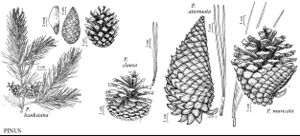Difference between revisions of "Pinus muricata"
Trans. Linn. Soc. London, Bot. 17: 441. 1836.
FNA>Volume Importer |
imported>Volume Importer |
||
| (6 intermediate revisions by 2 users not shown) | |||
| Line 8: | Line 8: | ||
}} | }} | ||
|common_names=Bishop pine | |common_names=Bishop pine | ||
| + | |special_status={{Treatment/ID/Special_status | ||
| + | |code=C | ||
| + | |label=Conservation concern | ||
| + | }} | ||
|basionyms= | |basionyms= | ||
|synonyms={{Treatment/ID/Synonym | |synonyms={{Treatment/ID/Synonym | ||
|name=Pinus muricata var. borealis | |name=Pinus muricata var. borealis | ||
|authority=Axelrod | |authority=Axelrod | ||
| − | }}{{Treatment/ID/Synonym | + | |rank=variety |
| + | }} {{Treatment/ID/Synonym | ||
|name=Pinus muricata var. cedrosensis | |name=Pinus muricata var. cedrosensis | ||
|authority=J.T. Howell | |authority=J.T. Howell | ||
| − | }}{{Treatment/ID/Synonym | + | |rank=variety |
| + | }} {{Treatment/ID/Synonym | ||
|name=Pinus muricata var. stantonii | |name=Pinus muricata var. stantonii | ||
|authority=Axelrod | |authority=Axelrod | ||
| − | }}{{Treatment/ID/Synonym | + | |rank=variety |
| + | }} {{Treatment/ID/Synonym | ||
|name=Pinus radiata var. binata | |name=Pinus radiata var. binata | ||
|authority=(Engelmann) Brewer & S.Watson | |authority=(Engelmann) Brewer & S.Watson | ||
| − | }}{{Treatment/ID/Synonym | + | |rank=variety |
| + | }} {{Treatment/ID/Synonym | ||
|name=Pinus remorata | |name=Pinus remorata | ||
| − | |authority= | + | |authority= |
| + | |rank=species | ||
}} | }} | ||
|hierarchy=Pinaceae;Pinus;Pinus muricata | |hierarchy=Pinaceae;Pinus;Pinus muricata | ||
| Line 38: | Line 47: | ||
|elevation=0–300m | |elevation=0–300m | ||
|distribution=Calif.;Mexico in Baja California. | |distribution=Calif.;Mexico in Baja California. | ||
| − | |discussion=<p>The several varieties described for Pinus muricata reflect the high variability in leaf characters and in degree of elaboration of apophysis and umbo in this species. The extremes can sometimes occur together.</p><!-- | + | |discussion=<p>The several varieties described for <i>Pinus muricata</i> reflect the high variability in leaf characters and in degree of elaboration of apophysis and umbo in this species. The extremes can sometimes occur together.</p><!-- |
--><p>Of conservation concern.</p> | --><p>Of conservation concern.</p> | ||
|tables= | |tables= | ||
| Line 48: | Line 57: | ||
-->{{#Taxon: | -->{{#Taxon: | ||
name=Pinus muricata | name=Pinus muricata | ||
| − | |||
|authority=D. Don | |authority=D. Don | ||
|rank=species | |rank=species | ||
| Line 61: | Line 69: | ||
|publication title=Trans. Linn. Soc. London, Bot. | |publication title=Trans. Linn. Soc. London, Bot. | ||
|publication year=1836 | |publication year=1836 | ||
| − | |special status= | + | |special status=Conservation concern |
| − | |source xml=https:// | + | |source xml=https://bitbucket.org/aafc-mbb/fna-data-curation/src/2e0870ddd59836b60bcf96646a41e87ea5a5943a/coarse_grained_fna_xml/V2/V2_469.xml |
|genus=Pinus | |genus=Pinus | ||
|species=Pinus muricata | |species=Pinus muricata | ||
Latest revision as of 20:23, 5 November 2020
Trees to 24m; trunk to 0.9m diam., straight to contorted; crown becoming rounded, flattened, or irregular. Bark dark gray, deeply furrowed, ridges long, scaly-plated. Branches spreading-ascending, often contorted; twigs stout to slender, orange-brown, aging darker brown, rough. Buds ovoid-cylindric, dark brown, 1–2.5cm, resinous. Leaves 2 per fascicle, spreading to upcurved, persisting 2–3 years, 8–15cm × (1.2–)1.5(–2)mm, slightly twisted, dark yellow-green, all surfaces with stomatal lines, margins strongly serrulate, apex abruptly conic-acute; sheath to 1.5cm, base persistent. Pollen cones ellipsoid, to 5mm, orange. Seed cones maturing in 3 years, serotinous, long-persistent, mostly in whorls, mostly asymmetric, lanceoloid-ovoid before opening, curved-ovoid when open, 4–9cm, glossy bright to pale red-brown, sessile or on stalks to 1cm, mostly downcurved, scales with deep red-brown border distally on adaxial surface; apophyses much thickened, the abaxial ones progressively more angulately dome-shaped toward base of cone; umbo central, a stout-based, curved claw. Seeds obliquely ellipsoid; body 6–7mm, dark brown to near black; wing 15–20mm. 2n =24.
Habitat: Dry ridges to coastal, windshorn forests, often in or around bogs
Elevation: 0–300m
Distribution

Calif., Mexico in Baja California.
Discussion
The several varieties described for Pinus muricata reflect the high variability in leaf characters and in degree of elaboration of apophysis and umbo in this species. The extremes can sometimes occur together.
Of conservation concern.
Selected References
None.
